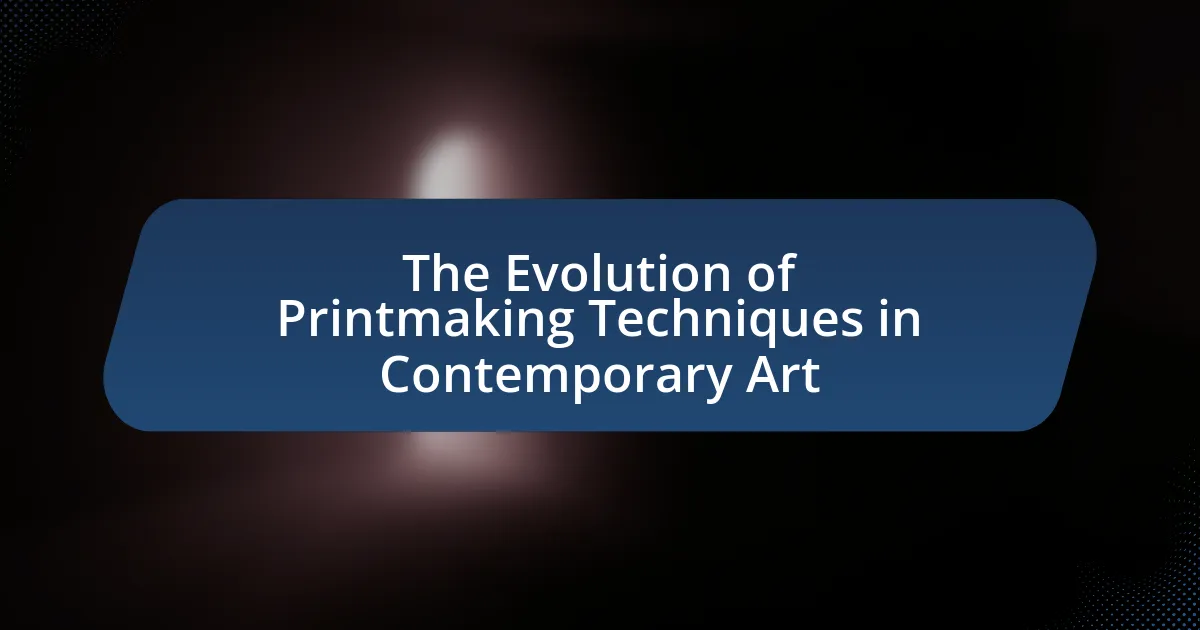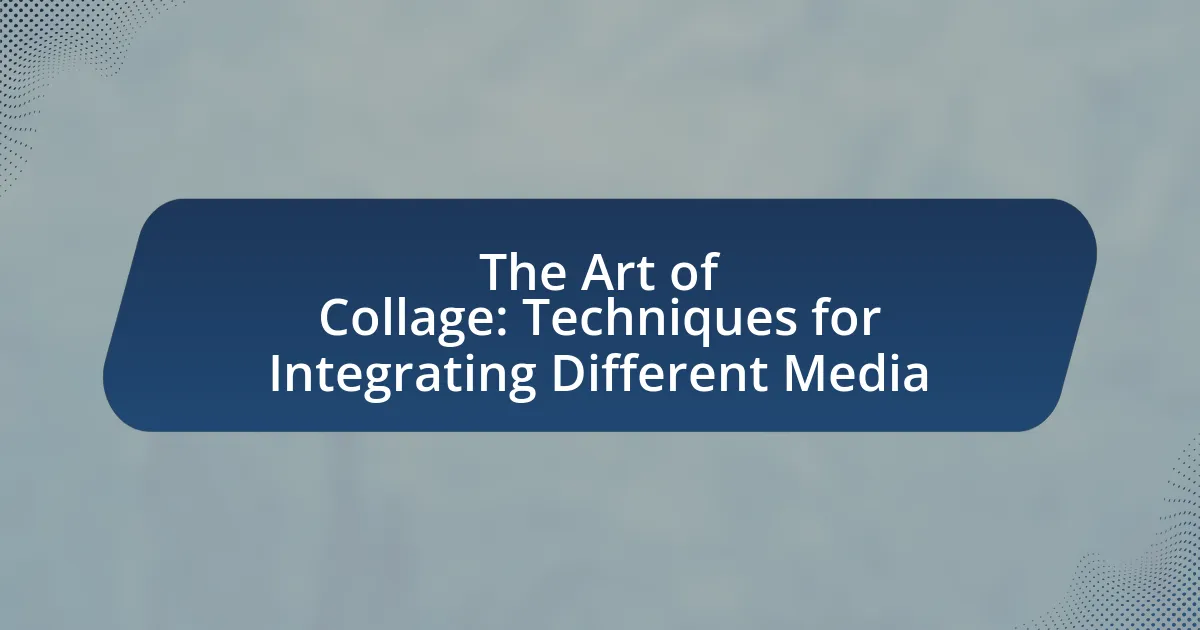The article examines the benefits of experimenting with unconventional materials in art, highlighting how this practice enhances creativity and innovation. It discusses the unique qualities these materials bring, such as new textures and forms, and their ability to provoke thought about sustainability and consumerism. The article also explores the influence of unconventional materials on the creative process, the importance of innovation in contemporary art, and the challenges artists may face when working with these materials. Additionally, it provides insights into techniques for incorporating unconventional materials, safety considerations, and resources available for artists interested in this approach.

What are the Benefits of Experimenting with Unconventional Materials in Art?
Experimenting with unconventional materials in art enhances creativity and innovation. Artists can break traditional boundaries, leading to unique expressions and new forms of artistic language. For instance, the use of recycled materials not only promotes sustainability but also challenges the perception of value in art, as seen in the works of artists like El Anatsui, who transforms discarded materials into stunning installations. Additionally, unconventional materials can evoke different sensory experiences, engaging audiences in novel ways and expanding the emotional impact of the artwork. This approach encourages interdisciplinary collaboration, as artists often draw from fields such as science and technology, further enriching the art-making process.
How can unconventional materials enhance artistic expression?
Unconventional materials can enhance artistic expression by providing unique textures, forms, and meanings that traditional materials may not offer. Artists utilizing items such as recycled plastics, organic matter, or industrial waste can challenge conventional aesthetics and provoke thought about sustainability and consumerism. For instance, the use of found objects in assemblage art allows for a narrative that reflects personal history and societal issues, as seen in the works of artists like Robert Rauschenberg, who famously incorporated everyday materials into his pieces. This approach not only broadens the scope of creativity but also invites viewers to engage with art on a deeper conceptual level, fostering a dialogue about the materials’ origins and implications.
What unique qualities do unconventional materials bring to art?
Unconventional materials bring distinct qualities to art, including innovation, texture, and conceptual depth. These materials, such as recycled objects, industrial waste, or organic substances, challenge traditional artistic boundaries and encourage artists to explore new forms of expression. For instance, using materials like plastic waste not only creates visually striking pieces but also raises awareness about environmental issues, thereby adding a layer of social commentary. Additionally, the varied textures and forms of unconventional materials can evoke different sensory experiences, enhancing viewer engagement. This approach has historical precedence, as seen in the works of artists like Robert Rauschenberg, who famously incorporated found objects into his art, demonstrating how unconventional materials can redefine artistic practice and meaning.
How do these materials influence the creative process?
Unconventional materials significantly influence the creative process by expanding the range of artistic expression and encouraging innovative thinking. Artists who experiment with these materials often discover new techniques and forms that challenge traditional boundaries, leading to unique outcomes. For instance, the use of recycled materials can inspire themes of sustainability and social commentary, while unexpected textures can evoke different emotional responses from the audience. Research indicates that engaging with diverse materials stimulates cognitive flexibility, enhancing problem-solving skills and fostering originality in artistic endeavors.
Why is it important for artists to explore unconventional materials?
Exploring unconventional materials is important for artists because it fosters innovation and expands creative boundaries. By utilizing non-traditional materials, artists can challenge conventional aesthetics and provoke new ideas, leading to unique artistic expressions. Historical examples, such as Marcel Duchamp’s use of found objects in the early 20th century, illustrate how unconventional materials can redefine art movements and influence contemporary practices. Additionally, research indicates that engaging with diverse materials can enhance problem-solving skills and adaptability, essential traits for artistic development.
What role does innovation play in contemporary art?
Innovation is crucial in contemporary art as it drives the exploration of new ideas, techniques, and materials, allowing artists to challenge traditional boundaries. This role is evident in the increasing use of unconventional materials, such as recycled objects and digital media, which expand the possibilities of artistic expression. For instance, artists like El Anatsui utilize discarded materials to create large-scale installations, emphasizing sustainability and social commentary. This innovative approach not only transforms the aesthetic experience but also engages audiences in critical dialogues about contemporary issues, demonstrating that innovation is a fundamental aspect of evolving artistic practices.
How can experimenting with materials challenge traditional art forms?
Experimenting with materials can challenge traditional art forms by introducing new textures, forms, and concepts that disrupt established artistic norms. For instance, artists like Anish Kapoor and Tara Donovan utilize unconventional materials such as resin and everyday objects to create works that defy traditional expectations of medium and technique. This approach not only expands the definition of what art can be but also encourages viewers to reconsider their perceptions of artistic value and craftsmanship. The incorporation of non-traditional materials often leads to innovative techniques and unexpected outcomes, fostering a dialogue about the nature of art itself.

What are some examples of unconventional materials used in art?
Unconventional materials used in art include everyday items such as found objects, recycled materials, and organic substances. Artists often utilize items like plastic bags, old newspapers, and metal scraps to create sculptures and installations, demonstrating creativity and resourcefulness. For instance, the artist El Anatsui is known for using discarded bottle caps to create large-scale wall hangings, transforming waste into intricate artworks. Additionally, artists like Andy Goldsworthy use natural materials such as leaves, stones, and ice to create ephemeral installations that highlight the beauty of nature. These examples illustrate how unconventional materials can challenge traditional notions of art and expand the boundaries of artistic expression.
How do artists select unconventional materials for their work?
Artists select unconventional materials for their work by exploring their personal experiences, cultural backgrounds, and the conceptual themes they wish to convey. This selection process often involves experimentation and a desire to challenge traditional artistic boundaries. For instance, artists may choose recycled materials to comment on environmental issues or use everyday objects to provoke thought about consumerism. The use of unconventional materials can enhance the narrative of the artwork, as seen in the works of artists like El Anatsui, who utilizes discarded bottle caps to create large-scale installations that reflect on waste and transformation. This approach not only broadens the scope of artistic expression but also engages viewers in new ways, prompting them to reconsider the value and meaning of materials in art.
What factors influence the choice of materials in artistic projects?
The choice of materials in artistic projects is influenced by factors such as the desired aesthetic, functionality, availability, and the artist’s personal experience. Artists often select materials that align with their vision and the message they wish to convey, as seen in the use of unconventional materials like recycled objects to create impactful statements about sustainability. Additionally, the accessibility of materials can dictate choices; for instance, local availability of certain mediums can lead artists to experiment with them. Personal experience also plays a crucial role, as artists may gravitate towards materials they are familiar with or those that challenge their skills, fostering innovation and creativity.
How do artists source unconventional materials?
Artists source unconventional materials through various methods, including scavenging, repurposing, and collaborating with other industries. Scavenging involves searching for discarded items in urban environments, while repurposing entails transforming everyday objects into art, such as using plastic waste or old machinery. Collaborations with industries, such as construction or manufacturing, can provide artists access to surplus materials that would otherwise be discarded. This practice not only fosters creativity but also promotes sustainability by reducing waste and encouraging innovative uses of materials.
What are the potential risks and rewards of using unconventional materials?
Using unconventional materials in art presents both significant risks and rewards. The rewards include enhanced creativity and innovation, as artists can explore new textures, forms, and concepts that traditional materials may not offer. For instance, artists like El Anatsui have successfully utilized discarded materials to create impactful works, demonstrating how unconventional choices can lead to unique artistic expressions.
Conversely, the risks involve potential safety hazards, such as toxicity or instability of materials, which can pose health risks to artists and viewers. Additionally, the durability and longevity of artworks may be compromised, leading to preservation challenges. For example, using organic materials can result in degradation over time, affecting the artwork’s integrity. Thus, while unconventional materials can inspire groundbreaking art, they also require careful consideration of safety and preservation issues.
What challenges might artists face when working with these materials?
Artists may face several challenges when working with unconventional materials, including difficulty in achieving desired effects, unpredictability in material behavior, and limited availability of resources. For instance, materials like found objects or organic substances can react differently than traditional art supplies, leading to unexpected results that may not align with the artist’s vision. Additionally, the sourcing of these materials can be inconsistent, making it hard for artists to replicate their work or maintain a cohesive body of art. Furthermore, unconventional materials may require specialized techniques or tools, which can complicate the creative process and increase production time.
How can the use of unconventional materials lead to unexpected outcomes?
The use of unconventional materials can lead to unexpected outcomes by fostering innovation and creativity in artistic expression. When artists incorporate non-traditional materials, such as recycled objects or industrial waste, they often discover new textures, forms, and interactions that challenge conventional aesthetics. For instance, the artist El Anatsui utilizes discarded bottle caps to create large-scale installations, resulting in visually stunning works that provoke thought about consumption and waste. This approach not only transforms the materials but also invites viewers to engage with the artwork on multiple levels, highlighting the potential for unconventional materials to inspire unique artistic narratives and experiences.

How can artists effectively incorporate unconventional materials into their practice?
Artists can effectively incorporate unconventional materials into their practice by actively exploring and experimenting with diverse textures, forms, and sources that challenge traditional art-making methods. This approach encourages innovation and creativity, allowing artists to create unique works that resonate with contemporary themes and societal issues. For instance, artists like El Anatsui utilize discarded materials such as bottle caps and aluminum to create large-scale installations, demonstrating how unconventional materials can convey powerful narratives and engage audiences on multiple levels. By embracing such materials, artists not only expand their artistic vocabulary but also contribute to sustainability in art, as seen in the growing trend of upcycling in contemporary art practices.
What techniques can artists use to work with unconventional materials?
Artists can use techniques such as assemblage, mixed media, and found object art to work with unconventional materials. Assemblage involves combining various materials, often from different sources, to create a cohesive artwork, allowing artists to explore texture and form in innovative ways. Mixed media techniques enable the integration of unconventional materials like fabric, metal, or recycled items with traditional mediums such as paint or ink, enhancing the visual and tactile experience of the artwork. Found object art focuses on repurposing everyday items, transforming them into artistic expressions, which challenges conventional notions of art and encourages sustainability. These techniques not only expand the creative possibilities for artists but also engage audiences in new dialogues about materiality and meaning in art.
How can artists combine different materials for innovative results?
Artists can combine different materials for innovative results by integrating diverse textures, colors, and forms to create unique visual experiences. This approach allows artists to explore the properties of each material, such as the interaction between organic and synthetic substances, which can lead to unexpected outcomes. For instance, the use of mixed media, where paint is combined with fabric or found objects, can enhance depth and dimension in artwork. Historical examples include the works of Pablo Picasso, who utilized collage techniques, and contemporary artists like Tara Donovan, who employs everyday materials to create large-scale installations. These practices demonstrate that the fusion of materials not only expands artistic expression but also challenges traditional boundaries in art.
What safety considerations should artists keep in mind when using unconventional materials?
Artists should prioritize safety by assessing the toxicity, flammability, and structural integrity of unconventional materials. Toxic substances can release harmful fumes or cause skin irritation, necessitating the use of gloves, masks, and proper ventilation. Flammable materials require careful handling and storage away from heat sources to prevent fires. Additionally, artists should evaluate the structural stability of materials to avoid accidents during the creative process. For instance, the National Institute for Occupational Safety and Health (NIOSH) emphasizes the importance of understanding material safety data sheets (MSDS) to identify hazards associated with various substances.
What are some best practices for experimenting with unconventional materials in art?
Best practices for experimenting with unconventional materials in art include thorough research on the properties and potential uses of the materials, maintaining a flexible mindset to adapt techniques, and documenting the process for future reference. Researching materials, such as biodegradable plastics or recycled items, allows artists to understand how these materials interact with traditional mediums, enhancing creativity. A flexible mindset encourages artists to embrace unexpected outcomes, which can lead to innovative results. Documenting the process, including successes and failures, provides valuable insights that can inform future projects and foster a deeper understanding of material behavior.
How can artists document their process and findings when using unconventional materials?
Artists can document their process and findings when using unconventional materials by employing a combination of visual documentation, written records, and digital tools. Visual documentation includes taking photographs or videos at various stages of the creative process, which allows artists to capture the evolution of their work and the interaction with the materials. Written records involve maintaining a journal or log that details the techniques used, challenges faced, and insights gained during experimentation. Digital tools, such as blogs or social media platforms, enable artists to share their experiences and findings with a broader audience, fostering community engagement and feedback. This multifaceted approach not only preserves the artist’s journey but also contributes to the collective knowledge of unconventional material use in art.
What resources are available for artists interested in unconventional materials?
Artists interested in unconventional materials can access a variety of resources, including online platforms, workshops, and community groups. Websites like Instructables and Pinterest offer tutorials and inspiration for using non-traditional materials in art. Additionally, local art centers and universities often host workshops that focus on innovative material use, providing hands-on experience. Community groups, such as those found on social media platforms, allow artists to share ideas and techniques, fostering collaboration and experimentation. These resources collectively support artists in exploring and expanding their creative practices with unconventional materials.





